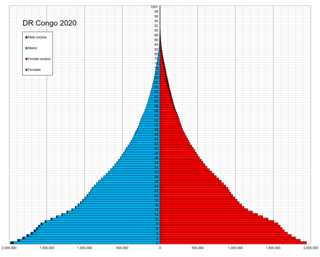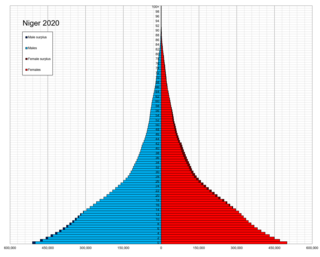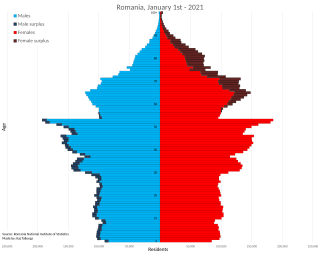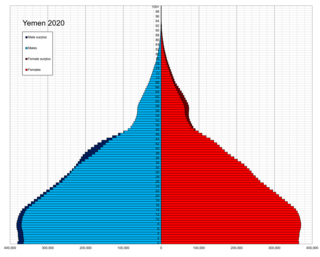| Demographics of Saudi Arabia | |
|---|---|
 Saudi Arabia population pyramid in 2020 | |
| Population | 32,175,224 (Saudi Census 2022) |
| Density | 14.967 people per sq. km of land (2022) [1] |
| Growth rate | 1.49% (2019) [2] |
| Birth rate | 13.9 births/1,000 population (2023) [3] |
| Death rate | 3.45 deaths/1,000 population |
| Life expectancy | 76.91 years |
| • male | 75.33 years |
| • female | 78.56 years |
| Fertility rate | 2.14 children born/woman (2022) [4] |
| Net migration rate | 590,000 (2017) [5] |
| Age structure | |
| 0–14 years | 24.44% |
| 15–64 years | 72.36% |
| 65 and over | 3.20% |
| Nationality | |
| Nationality | Saudis |
| Major ethnic | Arabs |
| Language | |
| Official | Arabic |
| Spoken | Arabic |

Saudi Arabia is the fourth largest state in the Arab world, with a reported population of 32,175,224 as of 2022. [6] [7] 41.6% of inhabitants are immigrants. [8] Saudi Arabia has experienced a population explosion in the last 40 years, [9] and continues to grow at a rate of 1.62% per year. [8]
Contents
- Population
- Structure
- Life expectancy at birth
- Density
- Vital statistics
- UN estimates
- Nationality and ethnicity
- Nationality
- Ethnicity
- Urbanization
- Migration
- People from other immigration jurisdictions
- Religion
- Languages
- References
- External links
Until the 1960s, most of the population was nomadic or semi-nomadic; due to rapid economic and urban growth, more than 95% of the population is now settled. 80% of Saudis live in ten major urban centers: Riyadh, Jeddah, Mecca, Medina, Hofuf, Ta'if, Buraydah, Khobar, Yanbu, Dhahran, and Dammam. [10] Some cities and oases have densities of more than 1,000 people per square kilometer. Saudi Arabia's population is characterized by rapid growth, far more men than women, and a large cohort of youths.
Saudi Arabia hosts one of the pillars of Islam, which obliges all Muslims to make the Hajj, or pilgrimage to Mecca, at least once during their lifetime if they are able to do so. The cultural environment in Saudi Arabia is highly conservative; the country adheres to the interpretation of Islamic religious law (Sharia). Cultural presentations must conform to narrowly defined standards of ethics.
Most citizens of Saudi Arabia are ethnically Arabs, the majority of whom are tribal. However, more than 40% of Saudi Arabia's population are non-citizens. [11] According to a random survey, most non-citizens living in Saudi Arabia come from the Indian Subcontinent and Arab countries. [12] Many Arabs from nearby countries are employed in the country, particularly Egyptians, [13] as the Egyptian community developed from the 1950s onwards. [14] There also are significant numbers of Asian expatriates, mostly from India, Pakistan, Bangladesh, Indonesia, Philippines, Syria and Yemen. In the 1970s and 1980s, there was also a significant community of South Korean migrant labourers, numbering in the hundreds of thousands, but due rapid economic growth and development in South Korea, most have since returned home; the South Korean government's statistics showed only 1,200 of their nationals living in Saudi Arabia (most of them being professionals and business personnels) as of 2005 [update] . [15] [16] There are more than 100,000 Westerners in Saudi Arabia, most of whom live in private compounds in the major cities such as Riyadh, Jeddah, Yanbu and Dhahran. The government prohibits non-Muslims from entering the cities of Mecca.























